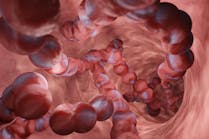Creatinine clearance blood sampling, differential with a normal CSF count, and cultures of intravenous catheter tips
Creatinine clearance blood sampling
Q: I have a question regarding the
timing of obtaining the serum creatinine in relation to the urine collection for a creatinine clearance. My lab is consolidating a few outpatient drawing stations with our sister hospital, and we have noted a significant difference in the serum creatinine draw time as part of the creatinine clearance. Our lab uses a policy of a six-hour window to obtain the serum creatinine (i.e., six hours before, during, or six hours after completion of the urine collection), and our counterpart uses a 48-hour window. Is there any science behind either of our policies? I do not find solid suggestions in Tietz, Henry or other sources.
A: The reader is not
alone in being unable to locate in the medical literature references that describe rules for collecting the blood samples for creatinine clearance (CCr) studies outside the period of the urine collection. My extensive Medline and Internet searches produced no articles to support this practice. I believe the practice of setting windows to allow for delayed delivery of the specimen from the home collection site to the laboratory was started by rationalizing pragmatists who find it hard to reject specimens, especially ones which cause the patient such inconvenience.
The rationale, as I understand it, is that plasma (or serum) creatinine levels are very stable in an individual. The serum creatinine concentration at the outside limits of the window supposedly closely matches its concentration at the midpoint of the urine collection period. This may be true for normal individuals and patients with stable, mild renal disease, but it certainly is not true for patients with active renal disease and patients with other diseases that actively affect the creatinine level (such as protein calorie malnutrition or a catabolic state1). The renal patients on peritoneal dialysis or hemodialysis perhaps have the most dynamic blood levels of creatinine during and after the dialysis. Even diet (e.g., excessive ingestion of roast meat or heavy tea drinking2) may influence creatinine concentration and, thereby, CCr actively.
Please understand that there is significant controversy about the current validity of the conventional CCr. Some advocate that it should be discontinued. Three types of studies are advocated in its place. The first is screening, which includes a Cystatin C assay,3 a creatol assay,4 and calculating a predicted CCr using serum creatinine concentration and other factors such as age, body mass, and gender. The second group includes several radionuclide clearance studies. Thirdly, a modification of the conventional CCr utilizes cimetidine, given before the urine collection period, to prevent the renal tubular secretion of creatinine, a significant factor in causing false elevations of CCr in patients with severe renal impairment.5,6
Louis Buettner, M.D.
Consulting Pathologist
DynacareAlabama Reference Laboratories/LabSouth
Tuscaloosa, AL
References
- Zarowitz RS. Is there a reliable index of glomerular filtration rate in critically ill patients? DICP. February 1991;25(2):169-178.
- De Giorgi A, et al. Creatinine clearance overestimated glomerular filtration rate in a heavy tea-drinker. Am J Kidney Dis. April 2001;37(4):877-888.
- Heget-Rosenthal S, et al. Cystatin C: efficacy as screening test for reduced glomerular filtration rate. Am J Nephrol. March-April 2000;20(2):97-102.
- Walser M. Assessment of renal function and progression of disease. Curr Opin Nephrol Hypertens. September 1994;3(5):564-567.
- Rahn KH, et al. How to assess glomerular function and damage in humans. J Hypertens. March 1999;17(3):309-317.
- Walser M. Assessing renal function from creatinine measurements in adults with chronic renal failure. Am J Kidney Dis. July 1998;32(1):23-31.
Differential with a normal CSF count
Q: For cerebrospinal fluids
(CSF) that are clear and colorless with a normal white blood count (WBC) of 0-5 cells/L, is there any significant reason for performing a cytocentrifuge differential?
A: The answer to a similar question
that was asked several years ago included a discussion of the methods for cytocentrifuge preparations of CSF, including technical problems associated with this method.1 That questioner also inquired about the usefulness of doing differential counts when the WBC is normal. I am not aware of any data which supports doing differentials on CSF when the WBC is within normal limits. In my view, if the WBC is within normal limits, then in most cases there does not seem to be any utility in performing a differential count.
It is conceivable that a mildly elevated WBC count could be artifactually lowered if the leukocytes may have lysed when counting was delayed. But that, hopefully, would not occur in the great majority of cases and should be preventable by careful sample collection and prompt processing.
However, there conceivably might be several reasons for carrying out a differential counting procedure even if the cell count is normal. For example, if a patient had had an abnormal CSF cell count, a complete examination, including a differential count, might be indicated to document the return to normality, or if the patients physician has reason to need a careful morphologic study (e.g., for possible early infection or malignancy, the clinician should be asked to indicate that need on the test requisition2).
This would be consistent with the recent trends for the streamlining of laboratory testing in which more definitive studies such as blood film evaluations are done only if the hematology specimen had been flagged by the automated instrument, or if the patients physician had a specific indication for such a labor-intensive study (Patrick W. Barnes, unpublished data, February 2002).
John A. Koepke, M.D.
Professor Emeritus of Pathology
Duke University Medical Center
Durham, NC
References
- Cerebrospinal fluid counts. In: Koepke JA. Tips on Hematology. Montvale, NJ: Medical Economics; 1996.
- Cheson, BD. Clinical utility of body fluid analysis. In: Schumann GB, ed. Clinics in Laboratory Medicine. Philadelphia: WB Saunders; 1985.
Cultures of intravenous catheter tips
Q: Recently, our laboratory was
asked to perform semiquantitative cultures of intravenous catheter tips to identify catheter-related bacteremia. Is this necessary? If so, what is the recommended procedure?
A: The best method for the
laboratory diagnosis of catheter-associated bacteremia remains controversial. In fact, the method may be different for short-term catheters compared to long-term catheters. Endoluminal and port-related colonization are important in long-term catheters, and therefore catheter-tip cultures may not detect infection.
That said, the most commonly used procedure is the semiquantitative method that necessitates removal of the catheter and rolling a 5 cm segment of the distal portion of the catheter across a blood agar plate.1 Cultures yielding more than 15 colonies are considered significant and suggest a catheter-related infection.
Many other techniques have been used to diagnose catheter-associated infections. Farr and associates conducted a meta-analysis of these catheter culture techniques and found that the accuracy of the method increased with increasing quantitation.2 That is, quantitative techniques are more accurate than semiquantitative methods, which are more accurate than qualitative procedures. The greater sensitivity of the quantitative sonication methods compared to the roll-plate method may be due to the detection of colonization of the catheter lumen.3 The most cost-effective test in the meta-analysis was an unpaired quantitative catheter blood culture, but this technique was only 78 percent sensitive. More recently, it was reported that the earlier positivity of central venous blood cultures compared with peripheral blood cultures is predictive of catheter-associated bacteremia.4
None of the techniques available for the diagnosis of catheter-associated infections is optimal for all situations. The method used should be based on the needs of your institution.
David Sewell, Ph.D., ABMM
Director of Microbiology
Veterans Affairs Medical Center
Portland, OR
References
- Maki DG, Weise CE, Safafin HW. A semiquantitative culture method for identifying intravenous-catheter-related infection.
NEJM. 1977;296:1305-1309. - Siegman-Igra Y, Anglim AM, Shapiro DE, Adal KA, Strain BA, Farr BM. Diagnosis of vascular catheter-related bloodstream infection: a meta-analysis. J Clin
Microbiol. 1997;35:928-936. - Sherertz RJ, Heard SO, Raad II. Diagnosis of triple-lumen catheter infection: comparison of roll plate, sonication, and flushing methodologies. J Clin
Microbiol. 1997;35:641-646. - Blot F, Schmidt E, Nitenberg G, et al. Earlier positivity of central-venous versus peripheral-blood cultures is highly predictive of catheter-related sepsis. J Clin Microbiol. 1998;36:105-109.
Daniel M. Baer is professor emeritus of laboratory medicine at Oregon Health and Science University in Portland, OR, and a member of MLOs editorial advisory board.
©
2002 Nelson Publishing, Inc. All rights reserved.







